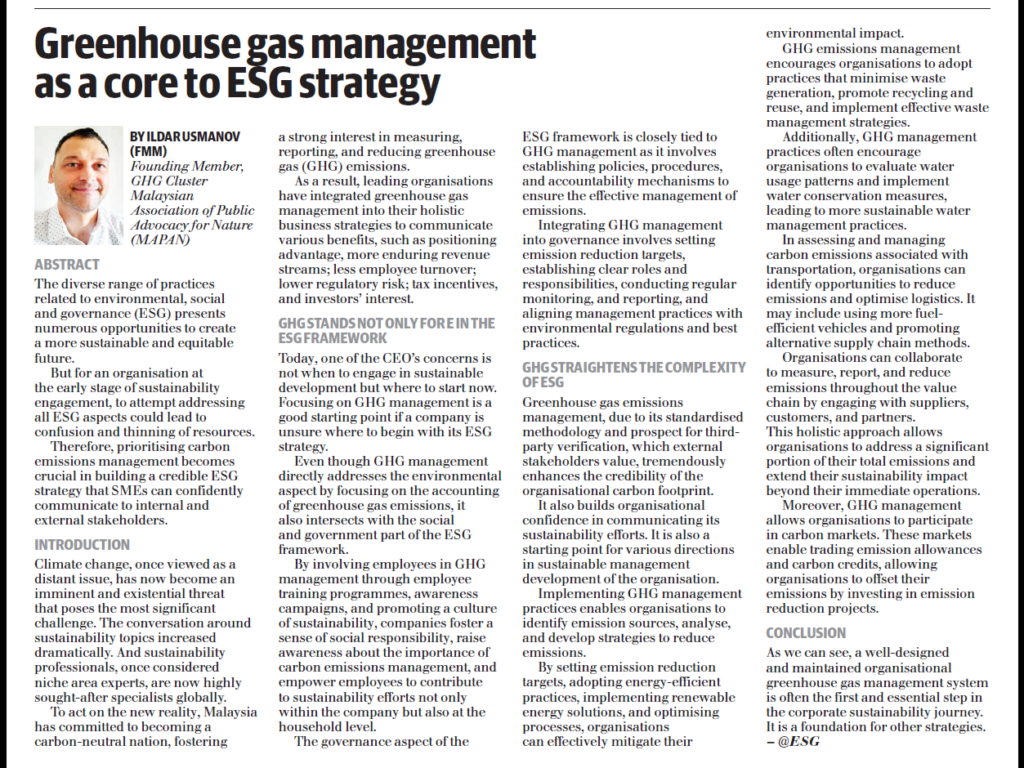The ESG framework covers a wide range of practices related to environmental impact, social responsibility, and corporate governance, offering opportunities for a sustainable and equitable future. However, organizations starting their sustainability journey must prioritize carbon emissions management to avoid confusion and resource depletion. This prioritization helps build a credible ESG strategy that SMEs can confidently communicate to stakeholders.
Climate change, once considered distant, now poses an imminent and existential threat. As the result, sustainability topics have gained significant attention over the past decade, turning sustainability professionals into highly sought-after experts worldwide.
Sustainable Scenario’s General Manager has outlined his opinion in @Green magazine about the importance of greenhouse gas management as the starting point and the foundation of any organizations Sustainable (ESG) Strategy.

GHG covers Environmental, Social, and Governance aspects
Malaysia aims to become a carbon-neutral nation, driving interest in measuring, reporting, and reducing greenhouse gas emissions. Leading organizations incorporate greenhouse gas management into their business strategies, enjoying benefits such as positioning advantage, enduring revenue streams, reduced turnover, lower regulatory risk, tax incentives, and investor interest.
Today, CEOs are concerned not about engaging in sustainable development but about where to start. Focusing on GHG management provides an excellent starting point for an ESG strategy. While it primarily addresses environmental aspects by measuring, reducing, and reporting emissions, it also intersects with the social and governance aspects of the ESG framework.
By involving employees in GHG management through training and awareness campaigns, companies foster social responsibility, raise awareness about carbon emissions, and empower employees to contribute to sustainability efforts both at work and in their households. Integrating GHG management into governance practices involves setting emission reduction targets, defining roles and responsibilities, regular monitoring and reporting, and complying with environmental regulations and best practices.
GHG Simplifies the complexity of ESG Strategy
Standardized GHG emissions management enhances organizational credibility and confidence in communicating sustainability efforts to external stakeholders. It also serves as a starting point for various sustainable management practices within the organization.
Implementing GHG management allows organizations to identify emission sources, develop strategies to reduce emissions, set targets, adopt energy-efficient practices, use renewable energy, and optimize processes to mitigate their environmental impact. GHG management also encourages recycling, and effective waste management, along with evaluating water usage and implementing conservation measures.
Organizations can also assess and manage emissions associated with transportation, leading to opportunities for reducing emissions and optimizing logistics through fuel-efficient vehicles and alternative transportation methods. Collaboration with suppliers, customers, and partners helps measure, report, and reduce emissions throughout the value chain, extending sustainability impact beyond immediate operations.
GHG management also opens opportunities for organizations to participate in carbon markets, where emission allowances and carbon credits can be traded to offset emissions through investments in emission reduction projects.
A well-designed and maintained organizational greenhouse gas management system serves as the crucial first step in the sustainability journey, laying the foundation for various strategies. Prioritizing GHG management enables organizations to make tangible progress towards a more sustainable future.